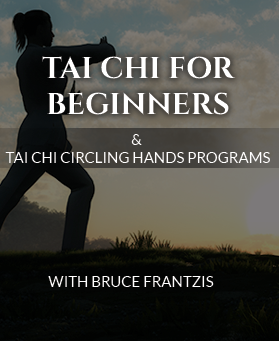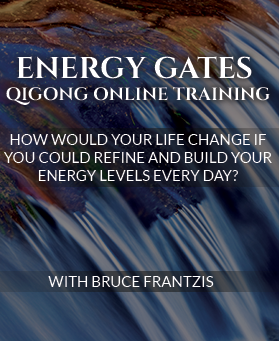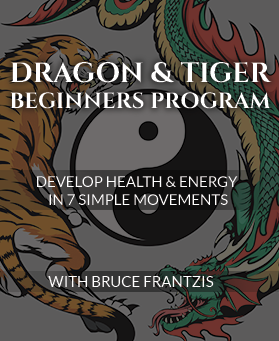BAGUA PRACTICES
There is virtually no other martial art system or style, internal or external, that has combined and seamlessly integrated the whole pantheon of martial art fighting techniques in one package as effectively as bagua zhang (ba gua chang/pakua chang). In bagua zhang, you can hit a person with an open hand, a fist or a push.
You can hit with your hand, head, shoulder or any other part of your body. You can punch straight ahead, in a round fashion or from every conceivable angle. You can also throw individuals without grabbing their bodies by tripping them through careful placement of your foot or by breaking their balance while controlling their arms and hands. You can use foot sweeps and leg cuts.
In addition, with bagua zhang you can lift an attacking man over your head and throw him on his back or on his face or head. There are also bagua chokes and joint-locks or chin na techniques as well as bagua grabbing techniques in which you seize your attacker’s skin and try to rip it off his body.
Bagua zhang also has a range of kicks both high and low, knee butts and stomping techniques and a full arsenal of traditional weapons.
Bagua Zhang: Simultaneously Fighting Eight Opponents
Bagua zhang was designed to fight up to eight opponents at once. This design is based on the inability of more than eight people to attack one person simultaneously without getting in each other’s way (unless armed with spears).
When facing multiple opponents, the bagua zhang fighter flows through the group of attackers, constantly twisting, turning and changing direction. From a defensive point of view, this minimizes the need to block attacks, since you are a continuously moving target that is no longer at the original location when the blow arrives.
Never remaining in one spot for more than a fraction of a second, the bagua zhang fighter intends to disable, or at least bypass, one opponent and continue on to the next before the first attacker is replaced. This efficiency can only be achieved through the deception and exploitation of angles of attack that most other martial arts do not utilize.
Bagua Zhang Practice Methods
Bagua’s Pre-Birth Method
In bagua zhang, the cultivation of energy and the fighting applications are based on two distinctively different practice methods. The first bagua zhang method taught by the founder, Dong Hai Chuan, involves Bagua Circle Walking techniques exclusively, and is referred to as the pre-birth method (or hsien tien in Chinese).
The simple act of Bagua Circle Walking creates a vortex that allows the practitioner to amplify, mix and control the natural energies that keep coming up from the earth and down from above. The twisting actions of bagua zhang create spirals of these energies according to the will of the practitioner.
Also, these spiraling energies can involuntarily move the practitioner’ chi (qi) and body. In later stages of practice, you are able to create energetic vortices that spiral up toward the sky and down toward the ground, simultaneously. These energies are used to create extremely powerful fighting applications.
Bagua’s Post-Birth Method
The second bagua zhang method, called the Post-birth method (or hou tien in Chinese), emphasizes bagua’ s (ba gua’s/pakua’s) fighting applications, not its health and meditation aspects. The post-birth method is often done in straight lines rather than by Bagua Circle Walking.
Bagua Zhang Martial Training
Throughout history, most of the best bagua (pakua) fighters used on a small number of fighting techniques, done with such power and skill that no more was needed. In Pre-birth bagua, students are first taught the internal components through the bagua single palm change. Later, they are taught how to expand those components to direct and power other physical movements.
“You practice bagua zhang until you recognize that there are not a hundred changes or hundreds of appearances of change, but actually only one. Until, through walking and the Single Palm Change, this reality can stabilize inside you so the one and only change can manifest—even as you change the energy of any martial application within the flicker of a thought. By moving your finger a fraction of an inch, a tiny little bit, all of a sudden, from what is inside, you can do any martial art change that exists and it will jump out of you spontaneously as a fighting application.” – Taoist Master Liu Hung Chieh, Excerpt from Bagua and Tai Chi: Discovering the Potential of Chi, Martial Arts, Mediation and the I Ching
Students typically would practice Bagua Circle Walking for one to several years. They would progressively add more and more internal neigong elements while they opened up the energy channels of the body with specific bagua energy postures and the Bagua Single Palm Change. As each internal component stabilized, they then found that any applications they knew became imbued with power.
Through this process, the body becomes very strong. The student can start to realize how the energy that is inside connects to the energy that is outside: how the yin and yang energies inside the body equate to the sun and moon in the heavens, how the microcosm and the macrocosm interconnect.
Once this foundation has been carefully laid, the student can next begin to learn the movements of the Eight Mother Palms, which, when done using the eight energies of the I Ching, are called the Eight Inner Palms, or nei ba chang.
HSING PRACTICES
Hsing-i’s Five Elements are in effect, the five energies that, according to Taoist cosmology, comprise the energy matrix of the universe. Working with the elements balances the internal organs of the human body. In traditional Chinese medical theory, these are the five dynamic energies:
Metal Element
Water Element
Wood Element
Fire Element
Earth Element
“There are many paths to cultivation of the body, but if you are seeking one that is simple and suitable for all ages, there is none like Xingyi (hsing-i) boxing, because this art specifically takes qi (chi) cultivation as its foundation. Splitting, Smashing, Drilling, Pounding, and Crossing correspond to metal, wood, fire, and earth and divide externally into the five positions. Internally they fill the five organs and are the natural, profound way to health.” – Sheng Jin, Forward to The Xingyi Boxing Manual [1923]
Each individual Hsing-i Five-Element utilizes a particular hand technique that moves power along a specific physical force vector: high (to the opponent’s heart or above), middle (between the heart and the lower tantien), and low (to the opponent’s hips, groin or legs).
Pi Chuan: Chopping/Splitting Fist (Metal Element)
The Hsing-i Pi Chuan technique, physical motion goes from up to down, utilizing pushing downward internal energy. This fist is linked to the Metal element, and Pi Chuan focuses on making an extremely strong spine, and hands as hard as steel.
Tsuan Chuan: Drilling Fist (The Water Element)
The Hsing-i Tsuan Chuan technique, physical motion goes from down to up using expansive energy. It is linked to the Water Element, and focuses on making the hands able to move around the opponent’s defense like water moves around a rock.
Beng Chuan: Crushing Fist (Wood Element)
The Hsing-i Beng Chuan technique uses straight-ahead physical motion along your centerline, or central axis. It is linked to the Wood Element, and focuses on making fists “grow” out of the body. It is often compared to the force of a powerful plant growing and expanding through concrete with a steady, inexorable force.
Pao Chuan: Pounding Fist (Fire Element)
The Hsing-i Pao Chuan technique focuses on diagonal physical motion. It is linked to the Fire Element and focuses on explosive and rapidly oscillating releases of power. In Pao Chuan, one hand initially contacts and shifts the opponent’s center of balance, while the other explodes into their body.
Heng Chuan: Crossing Fist (Earth Element)
The Hsing-i Heng Chuan technique focuses on the inside of the fist moving horizontally. It is linked to the Earth Element, and focuses on tightening the cross-linkages between the left and right sides of the inside of the abdominal cavity.
Hsing-i Martial Art Qualities
Hsing-i’s basic qualities as a martial art include:
- The energetic and combat intent behind a movement is emphasized more than the physical movements of the form.
- Functional power in each and every part of every movement, rather than only the ability to move well.
- Movements that are designed purely from the viewpoint of combat effectiveness. In hsing-i, any movement that is not functional or is wasted in either solo forms, two-person practices or in combat is to be the equivalent of a martial sin.
- Bu hao kan, hen hao yung (Chinese phrase that describes hsing-i), freely translated means that hsing-i does not look pretty, but works exceptionally well.
- A prime strategy that rests on the idea of never retreating.
- A mentality that is completely goal-oriented and based on a high level of calm aggression.
- A primary focus on developing yang (not yin) methods of internal power.
- Developing the outside of a practitioner’s body to feel extremely hard to someone attacking it.
- A main philosophical orientation toward developing internal strength and unwavering focused intent.
The image frequently used to describe the technique of hsing-i is that of an iron ball rolling right over the opponent. Whether your body type is thin or heavy set, one of your major internal goals in hsing-i is to sink your chi to make your body and arms become incredibly heavy.





Will Energy Arts offer an online program for Hsing-I in the near future? There was the DVD course at one time, but will there be a Hsing-I Mastery program like Bagua or Tai Chi?
Thanks
Hi, the DVD is a mastery course which is now online and can be purchased. Please inquire here: support@energyarts.com